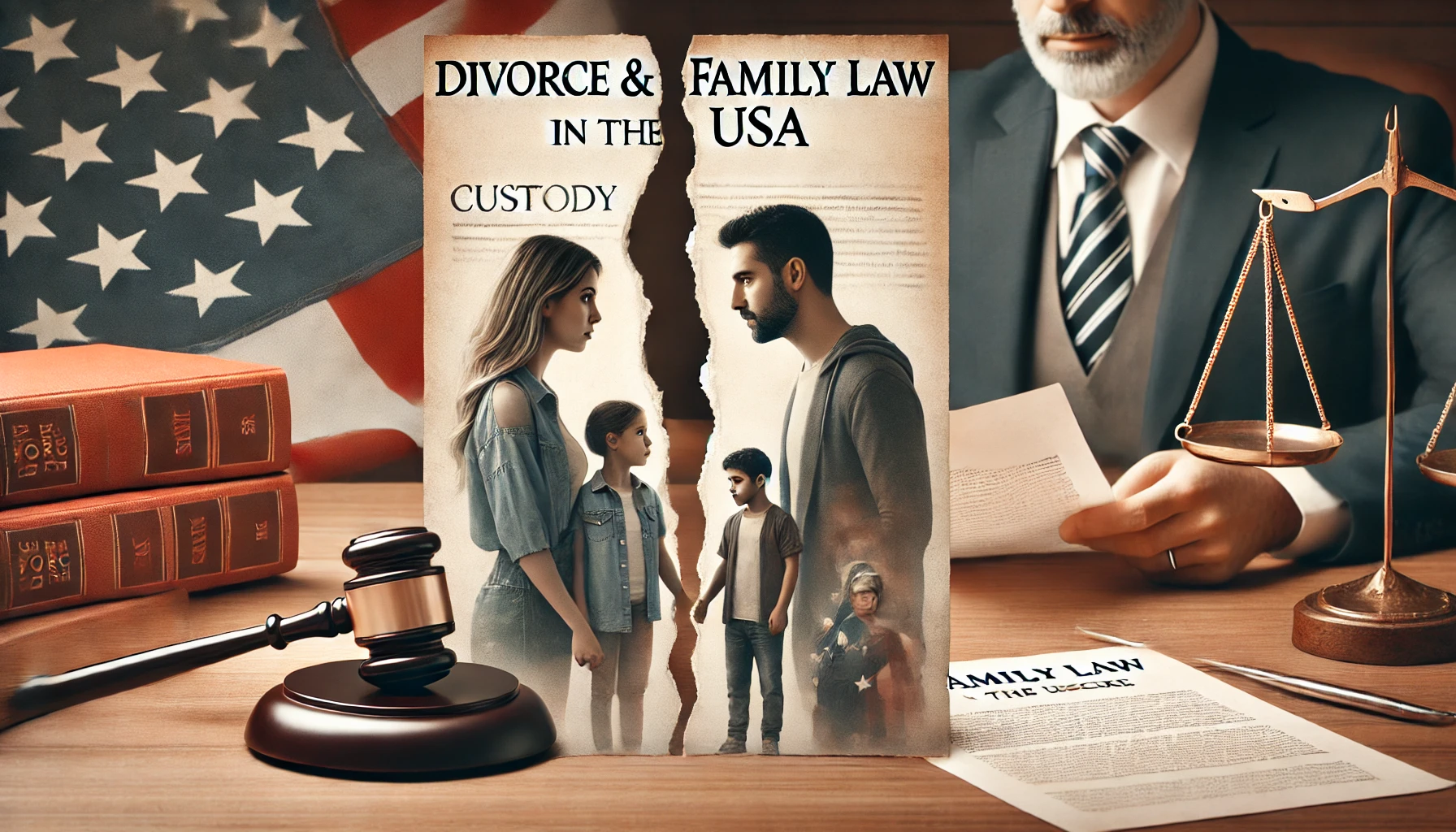What You Really Need to Know Before Making Life-Changing Decision
Divorce. Custody. Alimony. These aren’t just legal terms — they’re deeply personal, emotional, and life-altering issues.
If you’re going through a separation, custody battle, or any family law issue, you’re likely overwhelmed. Questions like:
- “Will I lose my kids?”
- “How much will I have to pay in support?”
- “Do I need a lawyer?”
…are all completely normal.
In this blog, we’ll walk you through everything you need to know about Divorce & Family Law in the USA — so you can make informed, empowered decisions for yourself and your family.
👨👩👧👦 What Falls Under Family Law?
Family law covers legal matters involving family relationships. This includes:
- Divorce
- Child custody and visitation
- Child support
- Alimony (spousal support)
- Property division
- Adoption
- Guardianship
- Domestic violence and restraining orders
Let’s start with the most common and complicated: Divorce.
💔 Divorce in the USA: The Basics
🏛️ Is Divorce a State or Federal Matter?
Divorce law is handled at the state level, not federal. That means the rules vary depending on where you live. Whether you’re in California, Texas, Florida, or New York, each state has its own:
- Waiting periods
- Property division laws
- Custody standards
✅ Check divorce laws in your state here (Nolo Legal Directory)
⚖️ Types of Divorce
1. Uncontested Divorce
Both parties agree on everything: property, support, custody. It’s cheaper, faster, and usually doesn’t go to court.
2. Contested Divorce
You disagree on one or more issues. These often require mediation or court involvement.
3. No-Fault Divorce
You don’t have to prove wrongdoing. Most states allow this. Common reason cited: “irreconcilable differences.”
4. Fault-Based Divorce
Less common. One party must prove the other’s wrongdoing (adultery, abuse, abandonment, etc.)
📽️ Video resource: What Is a No-Fault Divorce? (LegalZoom)
💰 Alimony (Spousal Support)
Alimony is money paid by one spouse to another after divorce. It’s not automatic — it depends on:
- Length of marriage
- Income differences
- Age and health
- Whether one spouse stayed home to raise kids
Some states have formulas, others leave it to the judge’s discretion.
🎥 Alimony Explained – US Legal Guide
👶 Child Custody & Visitation
Courts in every U.S. state prioritize the best interests of the child.
Types of custody:
- Legal Custody – who makes major decisions
- Physical Custody – where the child lives
- Joint Custody – shared by both parents
- Sole Custody – one parent has full rights
Visitation rights are usually granted to the non-custodial parent unless there are safety concerns.
🛠️ Want a state-by-state breakdown?
🔗 Find your state’s custody laws here (Child Welfare Information Gateway)
💵 Child Support
Each state has a calculator to determine child support based on:
- Income of both parents
- Number of children
- Time each parent spends with the child
Failure to pay child support can lead to wage garnishment, license suspension, and even jail time.
🧮 Try this:
🔗 Child Support Estimator – All States (AllLaw.com)
🏠 Who Gets What? Property Division
The way marital property is divided depends on your state.
There are two systems:
- Community Property States (like California, Texas, Nevada)
- All assets acquired during marriage are split 50/50.
- Equitable Distribution States (like New York, Florida, Illinois)
- Assets are divided “fairly” but not necessarily equally.
Separate property (inherited or owned before marriage) typically stays with the original owner.
💡 TIP: Always document assets and debts before filing!
🚨 Domestic Violence & Protection Orders
If abuse is involved — whether physical, emotional, or financial — you can file for a restraining order or order of protection.
This can include:
- No contact orders
- Temporary custody
- Emergency housing assistance
📞 National Domestic Violence Hotline: 1-800-799-SAFE (7233)
🔗 Visit the hotline website for support
🤝 Do You Need a Lawyer?
If your divorce or custody situation is simple and uncontested, you may be able to file pro se (by yourself).
But if your case involves:
- Property division
- Children
- Alimony
- Domestic violence
- A spouse with a lawyer
👉 Then yes — get legal help.
Most family lawyers offer a free consultation. Don’t wait until things get ugly.
🔗 Find a family lawyer in your state (Lawyers.com)
🕒 How Long Does Divorce Take
It varies by state and case complexity.
- Uncontested: 1–6 months
- Contested: 6 months to 2+ years
Most states have a mandatory waiting period (e.g., 6 months in California).
📝 Documents You’ll Need
- Marriage certificate
- Tax returns
- Pay stubs
- Bank and credit card statements
- Mortgage or lease info
- Parenting plan (for custody cases)
💡 Organize these before filing. It saves stress and lawyer time.
📬 Helpful Extras
Here are more trusted resources to help guide you:
🔗 Divorce Support & Legal Library (Nolo)
🔗 State Court Divorce Forms (US Courts)
🎥 What Happens in a Family Court Hearing? (Legal Aid NYC)
🧠 Final Thoughts: Stay Calm, Stay Informed
Divorce and family law situations are emotionally draining — but they don’t have to destroy your life.
Remember:
- You have rights.
- You have options.
- You will get through this.
Take it one step at a time. Get help when you need it. Protect your kids, your peace of mind, and your future.
📞 Need Help Now?
Use the form below to connect with a family law attorney near you.
✅ 100% confidential
✅ No pressure or obligation
✅ Free consultation
📬 Stay Connected
Subscribe to get more legal guides, real-life divorce stories, and tools to help you rebuild life on your terms.

